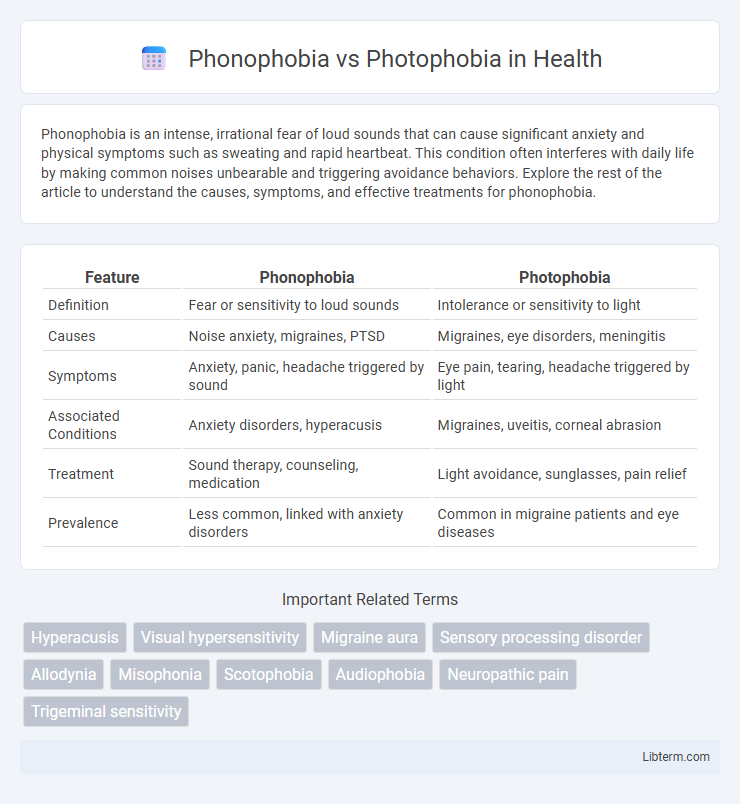Phonophobia is an intense, irrational fear of loud sounds that can cause significant anxiety and physical symptoms such as sweating and rapid heartbeat. This condition often interferes with daily life by making common noises unbearable and triggering avoidance behaviors. Explore the rest of the article to understand the causes, symptoms, and effective treatments for phonophobia.
Table of Comparison
| Feature | Phonophobia | Photophobia |
|---|---|---|
| Definition | Fear or sensitivity to loud sounds | Intolerance or sensitivity to light |
| Causes | Noise anxiety, migraines, PTSD | Migraines, eye disorders, meningitis |
| Symptoms | Anxiety, panic, headache triggered by sound | Eye pain, tearing, headache triggered by light |
| Associated Conditions | Anxiety disorders, hyperacusis | Migraines, uveitis, corneal abrasion |
| Treatment | Sound therapy, counseling, medication | Light avoidance, sunglasses, pain relief |
| Prevalence | Less common, linked with anxiety disorders | Common in migraine patients and eye diseases |
Introduction to Phonophobia and Photophobia
Phonophobia is characterized by an intense fear or aversion to loud sounds, often linked to anxiety disorders or migraine episodes. Photophobia involves hypersensitivity to light, causing discomfort or pain in the eyes, commonly associated with conditions like migraines, meningitis, or eye inflammation. Both conditions significantly impact daily functioning and require accurate diagnosis for effective management.
Defining Phonophobia: Fear of Sound
Phonophobia is characterized by an intense, irrational fear of certain sounds or loud noises, often triggering anxiety or panic attacks. Unlike photophobia, which pertains to sensitivity or discomfort caused by light, phonophobia centers on auditory stimuli and can significantly impact daily functioning. This condition frequently coexists with disorders such as migraine, hyperacusis, or post-traumatic stress, highlighting the need for accurate diagnosis and tailored treatment strategies.
Understanding Photophobia: Sensitivity to Light
Photophobia is a sensory symptom characterized by an abnormal sensitivity to light, causing discomfort or pain in the eyes when exposed to bright or flickering light. It is commonly associated with migraine, meningitis, or eye conditions such as uveitis and corneal abrasions. Differentiating photophobia from phonophobia, which is sensitivity to sound, is crucial for accurate diagnosis and effective treatment in clinical settings.
Key Differences Between Phonophobia and Photophobia
Phonophobia is characterized by an extreme sensitivity or fear of loud sounds, whereas photophobia refers to an abnormal intolerance or sensitivity to light. Phonophobia mainly affects auditory processing and can cause anxiety or discomfort in noisy environments, while photophobia impacts visual perception, leading to eye pain or headaches in bright conditions. Understanding these distinctions is crucial for accurate diagnosis and targeted treatment strategies.
Common Causes of Phonophobia
Phonophobia, characterized by an intense fear or sensitivity to sound, commonly arises from neurological disorders such as migraines, post-traumatic stress disorder (PTSD), and hyperacusis. Unlike photophobia, which involves light sensitivity caused by eye conditions or migraines, phonophobia often results from auditory processing anomalies or psychological triggers. Identifying underlying causes like anxiety disorders or ear infections is crucial for effective management and treatment.
Typical Triggers of Photophobia
Photophobia, characterized by an abnormal sensitivity to light, typically triggers discomfort from bright sunlight, fluorescent lighting, or computer screens, leading to eye pain, headaches, and squinting. In contrast, phonophobia involves an aversion to or fear of loud sounds, often triggered by noises such as shouting, alarms, or thunderstorms. Understanding the distinct sensory triggers of photophobia is essential for effective management in conditions like migraines, meningitis, or eye strain.
Symptoms and Daily Impact
Phonophobia is characterized by an intense fear or sensitivity to sound, causing symptoms such as anxiety, panic attacks, and discomfort in noisy environments, which can severely limit social interactions and daily activities. Photophobia involves an abnormal sensitivity to light, resulting in symptoms like eye pain, headaches, and squinting, often leading to difficulty performing routine tasks in bright settings. Both conditions significantly disrupt quality of life by restricting exposure to common sensory stimuli, impacting work, social life, and overall well-being.
Diagnosis: How Experts Differentiate the Two
Phonophobia and photophobia are diagnosed through distinct clinical evaluations focusing on symptom triggers, with phonophobia involving an abnormal sensitivity to sound and photophobia relating to light intolerance. Experts utilize patient history, symptom description, and specific diagnostic tests such as audiometry for phonophobia and eye examinations for photophobia to differentiate the conditions. Accurate diagnosis hinges on identifying whether sound-induced discomfort or light-induced pain predominates, guiding targeted treatment strategies.
Treatment Options and Management Strategies
Phonophobia treatment centers on addressing underlying anxiety disorders using cognitive-behavioral therapy, exposure therapy, and, in some cases, medication such as anxiolytics or antidepressants. Photophobia management involves treating root causes like migraines, eye inflammation, or medication side effects with appropriate interventions, including migraine-specific drugs, anti-inflammatory eye drops, and protective eyewear. Both conditions benefit from lifestyle modifications to reduce triggers and improve patient comfort, emphasizing personalized approaches guided by clinical evaluation.
Living with Phonophobia or Photophobia: Tips and Support
Living with phonophobia or photophobia requires practical strategies to minimize discomfort and improve daily functioning. Utilize noise-canceling headphones or earplugs to reduce sound sensitivity in phonophobia, and wear UV-protective sunglasses or use blackout curtains for photophobia to limit light exposure. Support from healthcare professionals, support groups, and tailored coping techniques such as mindfulness and paced environmental adjustments significantly enhance quality of life.
Phonophobia Infographic

 libterm.com
libterm.com